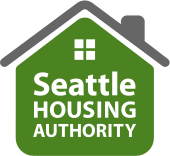SEATTLE—April 28, 2003—Why can't SHA replace all of the 481 low-income housing units at Rainier Vista right there on site, instead of replacing some of the units in other areas?
This has been a lingering question in the minds of advocates who have opposed SHA's redevelopment plans for Rainier Vista.
As part of a settlement reached with opponents of the redevelopment in December of 2002, SHA commissioned a feasibility study to provide an answer to that question.
The Rainier Vista Economic Feasibility Study examines the financial feasibility of four alternatives to SHA's current redevelopment plans for Rainier Vista. Each alternative replaces all 481 of the low-income units at Rainier Vista prior to redevelopment on site in the new community. This contrasts with SHA's redevelopment plan, which calls for 71 units to be replaced elsewhere in Seattle, with the remainder on site.
The study analyzed the financial feasibility of four options:
- Substitute on-site units currently planned for households with incomes up to 60 percent of area median income with 71 units restricted to households with incomes at or below 30 percent of area median income. The consultants concluded that this alternative would result in a funding gap of $12.2 million.
- Acquire the mini-mart at the corner of Martin Luther King Junior Way South and South Alaska Street and develop 71 low-income units there. This would result in a funding gap of $16.2 million, and would also require a time-consuming change in zoning, which could increase the gap. (SHA is currently negotiating this acquisition with the owner of the mini-mart building. If the purchase goes through, SHA will plan its redevelopment within the existing zoning.)
- Do not consider the 100 planned units for elderly and disabled low-income households as replacement housing. Therefore, 100 additional replacement units would need to be created, and the number of for-sale units would need to be reduced in order to keep the density level the same. This would result in a funding gap of $20.3 million, which includes the loss in revenue resulting from fewer for-sale units. It would also result in a higher concentration of low-income residents on the site.
- Replace all 481 units as conventional public housing. This results in a funding gap of $32 million.
The study also evaluated the feasibility of SHA's current redevelopment plans which call for 71 off-site replacement units and 510 rental units on-site, 410 of which will be affordable to households with incomes at or below 30 percent of the area median (considered as replacement housing) and 396 for-sale units.
The study identified a funding gap of $10.5 million with this program. The redevelopment plans are still being refined and SHA has already identified a variety of options for addressing this shortfall, including the following:
- Contribute the developer fee SHA will get as part of the tax credit financing to the costs of the project.
- Perform value engineering to reduce construction costs.
- Take advantage of favorable financing.
- Adjust subsidy types to increase rental income to SHA without changing the affordability of units to low-income households.
- Generate revenue through commercial development. (This was not taken into account in the current study.)
The feasibility analysis confirms that SHA's approach to the redevelopment, within existing zoning and the guidelines in the Memorandum of Agreement with the City is sound.
